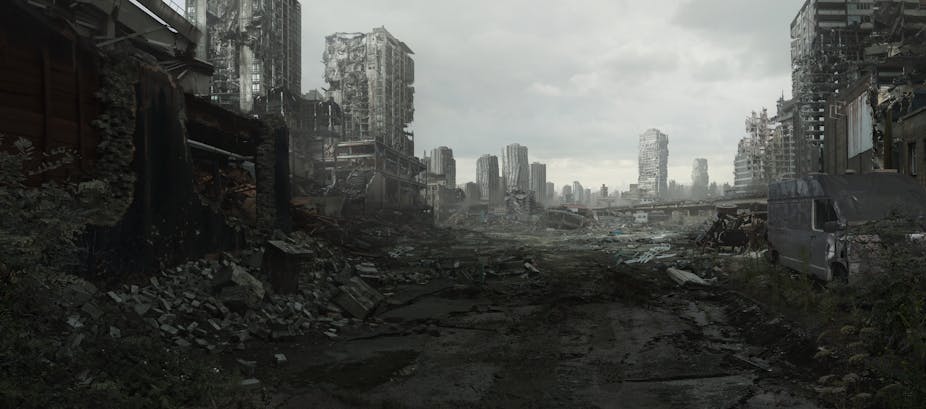The release of Fallout 76, the latest in Bethesda’s nuclear-themed video game franchise, is going down as a blockbuster game done badly.
Described by Brandin Tyrrel from IGN Entertainment as a “technically shaky” game of contradictory experiences and monotonous play, sales of the title are already 80% down on Fallout 4 which was released in 2015. One reviewer described his time playing Fallout 76 as “almost hell, West Virginia” in reference to American singer-songwriter John Denver’s Country Roads (1971) track employed to market the game. Usually a safe commercial tactic (think Call of Duty and Fortnite), Bethesda’s decision to transform a rich single-player game into an online multiplayer experience has massively backfired. It’s a shame, as the series traditionally has much to offer those interested in American culture.
Read more: Fortnite gamers are motivated, not addicted
Fallout has proven so well-liked and successful because of its detailed exploration of one of the video game industry’s favourite settings: the end of the world and the post-apocalypse.

Stories of the Cold War going hot, and of dangerous forces taking over, have been a staple of the video game narrative for some time. In the early 1980s, when US President Ronald Reagan embarked on a period of saber-rattling with the Soviet Union, titles such as Atari’s Missile Command (1980), Access’ Raid Over Moscow (1984) and Coleco’s WarGames (1984) – based on the 1983 American Cold War sci-fi movie of the same name, starring Matthew Broderick – all explored public attitudes around nuclear war. As film studies professor Kathleen McClancy contends, the Fallout series itself is an exercise in Cold War nostalgia.
More recently, titles such as The Last of Us (2013), Just Survive (2015) - now discontinued - and Horizon Zero Dawn (2017) have entertained different kinds of apocalyptic endgames. It seems there is no let up in the desire for disaster fiction.
Playing on society’s fears
Across almost five decades of play, video games have raised intriguing ideas about the end of America as a nation, as well as what might emerge in its place. Themes of technology that has run amok, of evil rogue leaders, and of imminent environmental collapse, are commonplace, reflective of society’s own fears.
In Naughty Dog’s highly-acclaimed The Last of Us, players follow a Texan father and a teenage girl as they navigate a United States devastated by a fungus contagion. In one early scene they wade through a flooded, destitute metropolis, a clear allusion to the impact of Hurricane Katrina on New Orleans in 2005. Video games have continually offered valuable social, political and ecological commentary.
Unlike other media, video games have also granted people the opportunity to explore apocalyptic scenarios for themselves. Video games have encouraged gamers to psychologically process conflicts such as the Cold War and the War on Terror as intimate events; allowing the traditional spectator to become an active (albeit fictional) participant. For example, in New World Computing’s Nuclear War (1989), a Spitting Image-style satire of superpower conflict, players saw “their” thumbs on screen pressing red buttons to release nuclear arsenals, linking them directly to the ensuing carnage, while in Crytek’s Crysis 2 (2011), the player, serving as a US Marine, defends New York City block by block from (extraterrestrial) terrorists.
Read more: Red Dead Redemption 2: can a video game be too realistic?
Going nuclear
The Fallout series has allowed gamers to explore the radioactive American wasteland in greater detail than most titles. In Fallout, players work long hours to scavenge resources, eek out an existence, and ultimately contribute to a new society.
In Fallout 76, the action takes place in an impressively rendered West Virginia – a rewarding experience of atomic-themed tourism. The West Virginia Tourism Board and State Governor Jim Justice both worked with Bethesda on promoting the title, and in-game locations closely resemble their real-life, non-radioactive counterparts. The locations also resemble actual ghost towns of the atomic age, with the abandoned Ferris Wheel at Tyler County Fairgrounds in the game eerily reminiscent of that found in the deserted amusement park of Pripyat, near Chernobyl.

However, what is missing in the new Fallout title is an engrossing narrative to back up the apocalyptic visuals. With its new multiplayer focus and decision to cast aside computer-controlled characters (all characters in the game are played by other players), Bethesda has produced a game of limited story and cultural relevance. Fallout 76 exists as a stripped down version of prior Fallout games, a digital ruin to wander through but without purpose.
While exploring the atomic wasteland is always strangely alluring, as players we typically want a deeper motivation: be it some people to save or a valid reason to rebuild. While Bethesda’s catchy slogan of “Reclamation Day” (a play on Independence Day) initially promises exactly that, of rebuilding a nation, there is simply not enough reason to survive the apocalypse in Fallout 76.


